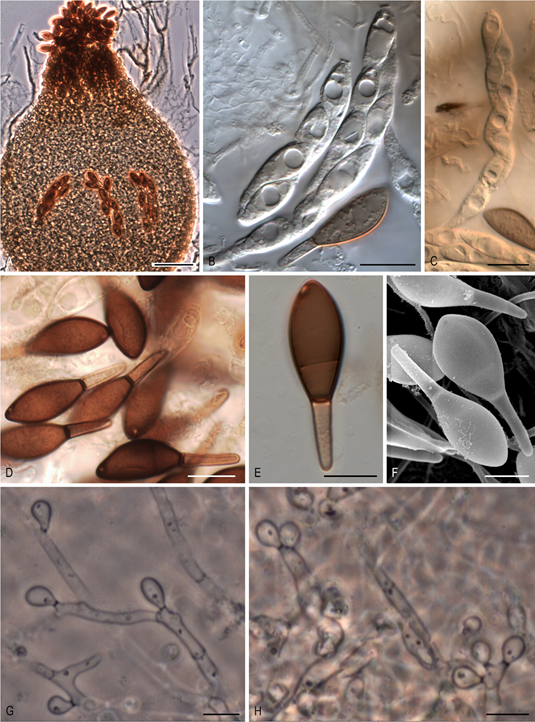Naviculispora Stchigel, Y. Marín, Cano & Guarro, in Marin-Felix, Miller, Cano-Lira, Guarro, García, Stadler, Huhndorf & Stchigel, Microorganisms 8(9, no. 1430): 14 (2020)
Index Fungorum number: IF 812135; Facesoffungi number: FoF 14640
Etymology – From Latin navicularibus-, navicular, and –sporarum, spore, referring to the shape of the ascospores.
Type species – Naviculispora terrestris Stchigel, Cano, Y. Marín & Guarro.
Sexual morph Ascomata ostiolate, brown, pyriform, covered with septate hyphae-like hairs; neck short, dark brown, papillate. Ascomatal wall membranaceous, textura angularis. Asci unitunicate, eight-spored, cylindrical, short stipitate, with a small apical ring, evanescent. Ascospores at first one-celled, hyaline, clavate, becoming transversely septate and two-celled; upper cell dark brown, navicular, septate, with a subapical to lateral germ pore; lower cell pale brown, cylindrical-conical, thick-walled, not collapsing with age; gelatinous cauda absent. Asexual morph Conidia holoblastic, hyaline to subhyaline, ellipsoidal to obovoid or clavate, sessile or less commonly on sympodially proliferating conidiophores.
Notes – Naviculispora spp. can be easily distinguished from the two phylogenetically related species of Arnium (Arnium caballinum and A. japonense) by the production of two-celled ascospores (one-celled in Arnium spp.). Areotheca, as well as Naviculispora, produces two-celled ascospores with a septum in the upper cell. However, these taxa differ in the nature of the ascomatal wall, being membranaceous in Naviculispora and cephalothecoid in Areotheca. As in Naviculispora spp., the upper cell of the ascospores in Bellojisia rhynchostoma, Cercophora sulphurella, Corylomyces selenospora, Podospora dydima, and Zopfiella tabulata is septate; however, the lower cell of the ascospores is pale brown to brown, thick-walled, and non-collapsing with age in Naviculispora spp., whereas, in the other taxa, it is hyaline (or nearly so) and collapses very soon, except for C. sulphurella. Zopfiella attenuata and Z. pleuropora, both located in a non-supported main clade (clade VI, Figure 1), also produce ascospores with a septate upper cell, but differ from the Naviculisporaceae by the production of non-ostiolate ascomata.

Figure 4. Naviculispora terrestris CBS 137295T. (A) Ascomata. (B,C) Asci. (D–F) Ascospores. (G) Conidia sessile. (H) Conidia borne on sympodially proliferating conidiophores. Scale bars: (A) = 100 µm; (B,C) = 20 µm; (D) = 15 µm; (E,F) = 10 µm; (G,H) = 5 µm.
Species
